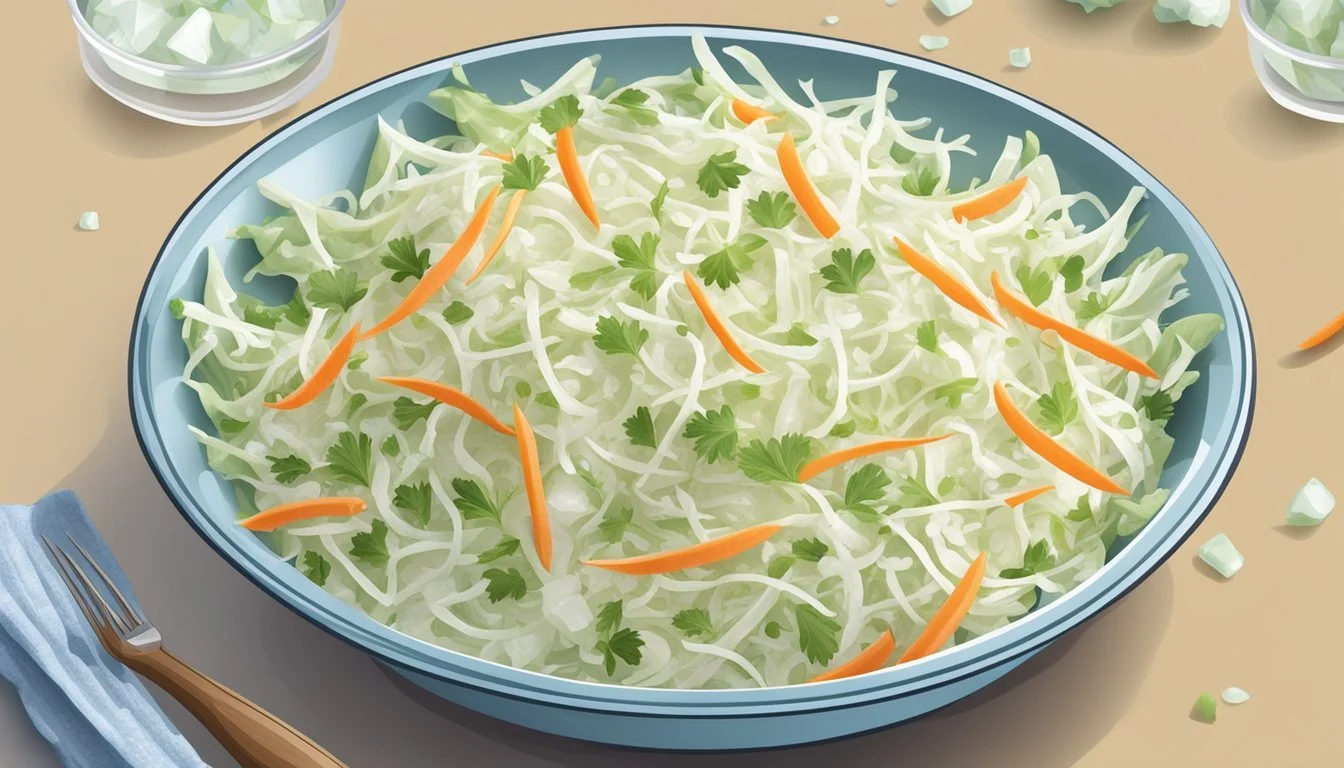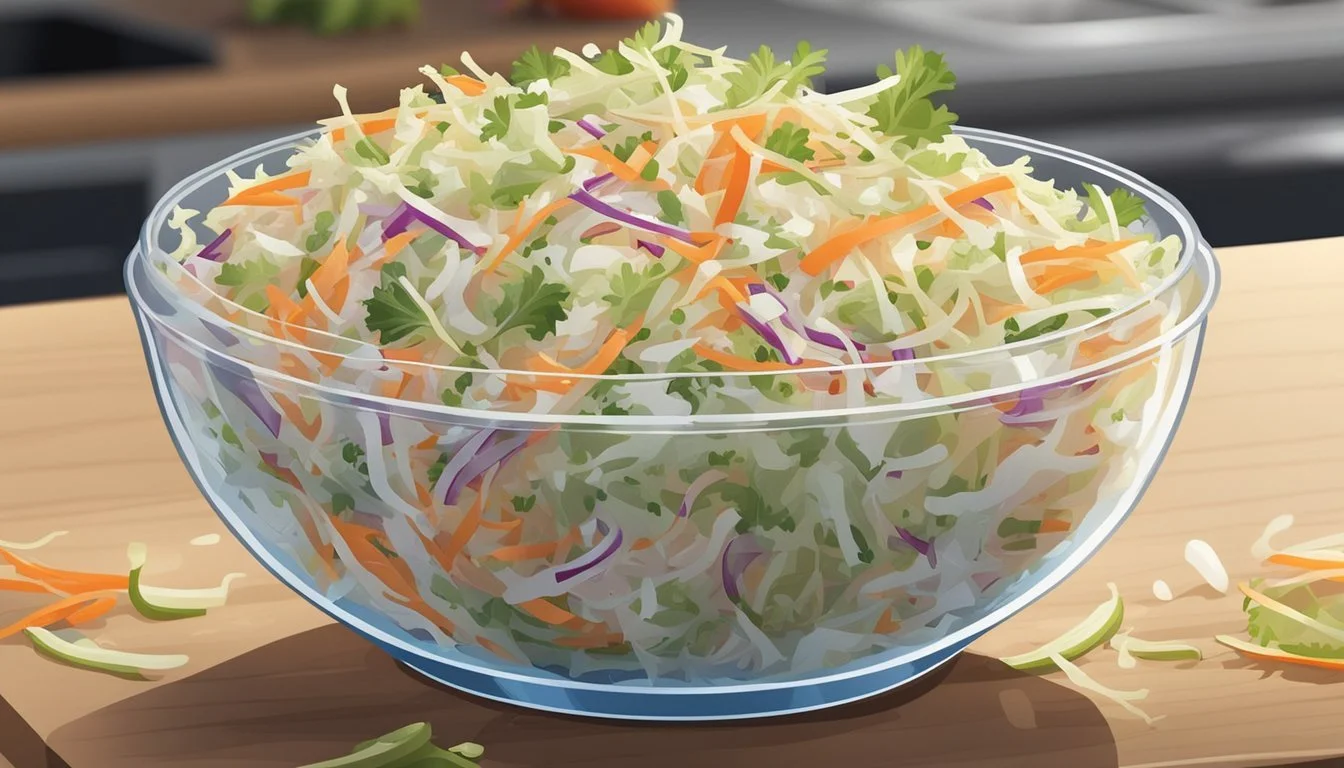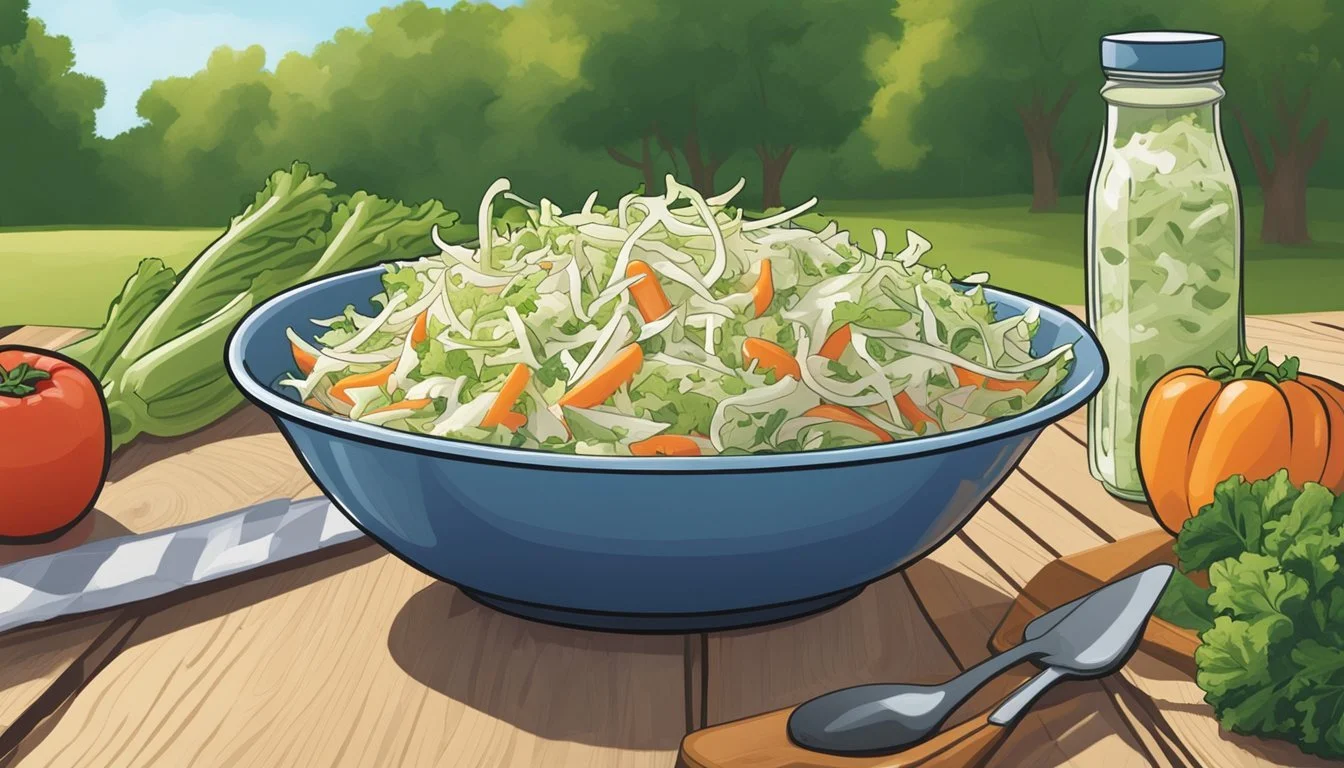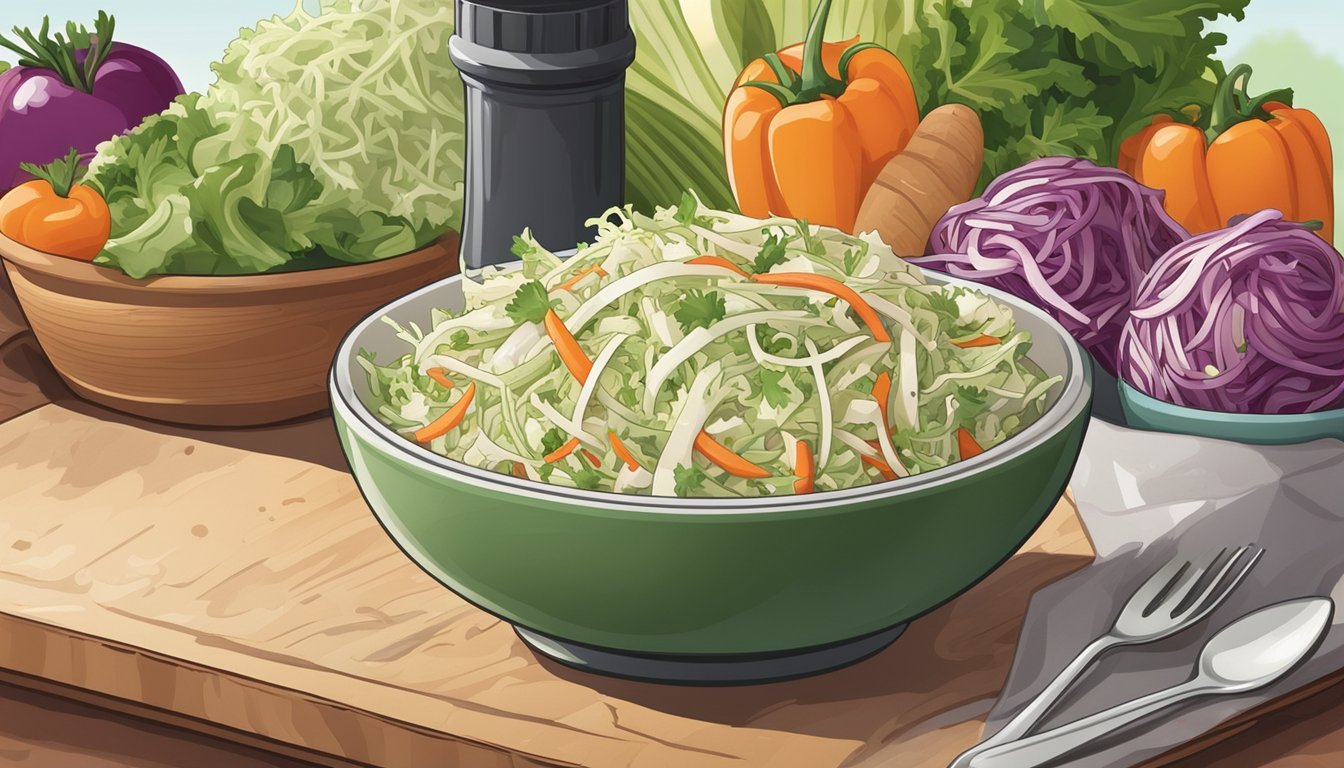How Long Does Freshly Prepared Coleslaw Last?
Shelf Life and Storage Tips
Coleslaw, a popular salad made with shredded cabbage and a dressing, is a staple at barbecues, picnics, and as a side dish in many meals. Its freshness and shelf life are dependent on several factors such as the ingredients used, the method of preparation, and storage conditions. Freshly prepared coleslaw can last relatively well under proper refrigeration.
The longevity of coleslaw in the fridge is typically between 3-5 days. The presence of mayonnaise or dairy-based dressings in the mix may shorten this window, as these ingredients tend to spoil more rapidly. Storing coleslaw in an airtight container is crucial to maximize its shelf life and maintain its quality by preventing the absorption of other odors and protecting it from contaminants.
Due to the perishable nature of the ingredients, it's important to store coleslaw at or below 40 degrees Fahrenheit. This helps to slow down bacterial growth and preserve the salad's texture and flavor. It's also essential to recognize the signs of spoilage such as an off smell, change in texture, or discoloration, and to discard any coleslaw that exhibits these characteristics to ensure food safety.
Understanding Coleslaw
Coleslaw, a popular salad predominantly made from shredded cabbage and carrots, varies in preparation methods and dressing options which influence its nutritional content and shelf life. Its simplicity and versatility make it a favored side dish across various cuisines.
Components and Varieties
Coleslaw typically consists of finely shredded cabbage and carrots, which serve as the base vegetables. Variations may include additional ingredients like red cabbage, onion, or apple for flavor diversity. The salad is bound together by either a mayonnaise-based dressing, vinegar-based dressing, or vinaigrette. Mayonnaise-based coleslaws offer a creamy texture, while vinegar or vinaigrette dressings provide a lighter and often tangier profile. Some recipes may substitute mayonnaise with alternatives like sour cream or yogurt for a different taste and texture.
Nutritional Profile
The nutritional content of coleslaw is largely determined by its ingredients. A typical serving of homemade coleslaw can vary in calories and nutrients but generally contains essential vitamins and minerals from the raw vegetables. The choice of dressing significantly affects the calorie and fat content; for example, mayo-based dressings tend to be higher in calories compared to a lighter oil or vinegar dressing.
Average Nutritional Information for Coleslaw (per serving):
Nutrient Mayonnaise-Based Vinegar-Based Calories Higher (due to mayo) Lower Fat Content Higher (due to mayo) Lower Essential Vitamins Present (from vegetables) Present (from vegetables)
Popularity and Uses
Coleslaw is widely enjoyed for its crunchy texture and ability to complement a variety of dishes. It is a common side item at barbecues and picnics, often served alongside grilled meats and sandwiches. Both homemade and store-bought coleslaw can be found across the globe, with regional variations adapting the basic recipe to local tastes and available ingredients. Its popularity owes much to its simple preparation and the balance it brings to richer, hearty meals.
Freshness and Storage
Proper storage methods and an understanding of shelf life factors are essential to maintaining the freshness and safety of prepared coleslaw. Adhering to food safety considerations can extend coleslaw's shelf life and minimize the risk of spoilage.
Storage Methods
To preserve the quality of coleslaw, it should be stored in an airtight container and refrigerated immediately. Coleslaw, especially when homemade, is not suitable for freezing as its quality can be compromised due to water separation and textural changes upon thawing.
Shelf Life Factors
The shelf life of coleslaw is influenced by several factors, including:
Temperature: Keep coleslaw refrigerated at or below 40°F to slow down bacterial growth.
Dressing base: Coleslaw with a mayonnaise-based dressing may spoil faster than vinegar-based due to the susceptibility of mayonnaise to bacteria.
Freshness of ingredients: Initially used fresher ingredients can prolong shelf life.
Typically, coleslaw lasts between 3 to 5 days when stored correctly.
Signs of Spoilage
Be vigilant of changes in:
Smell: A sour or unpleasant odor.
Color: Noticeable discoloration.
Texture: The presence of a slimy texture.
Any of these indicators suggest that the coleslaw should not be consumed.
Food Safety Considerations
To prevent foodborne illness, consider the following:
Danger Zone: Between 40°F and 140°F is where harmful bacteria like E. coli and Salmonella can thrive. Avoid leaving coleslaw at room temperature for more than 2 hours.
Cross-Contamination: Store away from raw meats to avoid cross-contamination.
Extending Coleslaw's Life
To maximize the lifespan of your coleslaw:
Humidity: Refrigerators with lower humidity levels can extend shelf life.
Store-Bought vs. Homemade: Preservatives in store-bought coleslaw may result in a longer shelf life, so always check the expiration date.
Observing these practices can help ensure that your coleslaw remains fresh and safe to eat within its intended shelf life.
Optimal Conditions for Freshness
To ensure the freshness of coleslaw, paying attention to storage conditions, container selection, and preventive measures against spoilage is essential. These factors play critical roles in preserving the crisp texture and preventing the growth of harmful bacteria.
Refrigerating Coleslaw
Coleslaw must be stored in the refrigerator at or below 40°F (4°C) to maintain freshness. Refrigeration significantly slows down bacterial growth, which is crucial for both mayo-based and vinegar-based coleslaw. The temperature inside the fridge should be consistent, as fluctuations can affect the coleslaw's quality.
Handling and Container Choice
When handling coleslaw, use clean utensils to avoid introducing contaminants. Store coleslaw in an airtight container to minimize exposure to air and moisture, which can degrade quality. Glass containers are preferred over plastic, as they can maintain a more stable environment.
Preventive Measures Against Spoilage
To minimize the risk of spoilage:
Keep coleslaw dry: Excess moisture from washing produce should be thoroughly drained before mixing with dressing.
Minimize exposure to air and light: Use a container that fits the amount of coleslaw closely without much extra space.
Considerations for Homemade Versus Store-Bought
Homemade coleslaw, made with fresh ingredients and without preservatives, may have a shorter shelf life than store-bought versions. Store-bought coleslaw often contains preservatives, which can extend shelf life. Regardless, always adhere to storage guidelines to ensure safety and quality.
Storage Duration by Coleslaw Type
The shelf life of coleslaw varies by type:
Mayo-based coleslaw: Lasts about 3-5 days in the fridge.
Vinegar-based coleslaw: Can last slightly longer due to the preservative nature of vinegar.
Homemade vs. Store-Bought:
Homemade: Consume within 3-4 days for optimal freshness.
Store-bought (unopened): Can often be safe to consume 2-3 days past the expiration date on the packaging.
Store-bought (opened): Should be eaten within 3-4 days.
Proper storage can maximize the shelf life and freshness of coleslaw, maintaining its texture and flavor.
Identifying and Managing Spoilage
When it comes to coleslaw, being able to identify signs of spoilage is crucial for health and safety. This section offers specific indicators to recognize spoiled coleslaw and what to do once spoilage is suspected.
Visual and Olfactory Clues
Visual and olfactory cues are the first line of defense when identifying spoiled coleslaw. Discoloration, such as a dull appearance or a change from its original vibrant color, can indicate spoilage. The presence of mold or any fuzzy growths on the surface is a clear sign that coleslaw should be discarded. A sour odor or an unpleasant smell that deviates from the fresh, tangy scent of coleslaw is a strong indication that bacterial growth may have occurred.
Taste and Texture Changes
Spoiled coleslaw's taste and texture provide immediate indications of spoilage. Fresh coleslaw should have a crisp texture and a balanced flavor. If the coleslaw tastes sour or has an off-flavor, it should not be consumed. Textural changes such as sliminess, sogginess, or a watery consistency suggest a breakdown of the vegetables and a loss of quality due to bacterial action.
Deciding When to Discard
Deciding when to discard coleslaw relies on observable factors. Any signs of spoilage, including odor, color, taste, or texture changes, warrant disposing of the product. If coleslaw has been stored improperly or beyond its optimal lifespan, typically 3-5 days in the fridge, it should be discarded to prevent health risks.
Health Risks of Spoiled Coleslaw
The consumption of spoiled coleslaw can pose health risks due to the presence of harmful bacteria. Food poisoning symptoms are a potential risk when eating coleslaw that has spoiled. To minimize health risks, it is crucial to monitor for signs of spoilage and to ensure coleslaw is consumed before bacterial growth renders it unsafe.
Special Considerations
In evaluating how long coleslaw retains its quality, it is pertinent to discuss specific contexts in which coleslaw is served. These include professional food service environments, social gatherings, and within health-conscious diets. Each setting imposes unique factors that influence the shelf life and quality of coleslaw.
Coleslaw in Professional Food Service
Professionals in the catering and restaurant industry adhere to strict food safety guidelines to ensure the quality of their dishes, including side dishes like coleslaw. The shelf life of coleslaw in these settings typically does not exceed 3-5 days when stored at a constant refrigeration temperature below 40°F (4°C). Critical points to maintain the quality of coleslaw in food service include:
Storing coleslaw in airtight containers to prevent contamination and slow down the degradation process.
Monitoring the expiration date of ingredients like mayonnaise, which can affect coleslaw's freshness.
Coleslaw at Social Events
At social events such as picnics, barbecues, and potlucks, coleslaw is a popular side dish alongside options like potato salad. For these occasions, coleslaw's quality can be compromised by prolonged exposure to warm temperatures. Food safety practices dictate that coleslaw should not sit out for more than two hours, and only one hour if the ambient temperature is above 90°F (32°C). If it exceeds this period, the risk of spoilage and foodborne illness increases significantly.
Coleslaw for Health-Conscious Diets
For individuals focusing on weight loss or adhering to a low-calorie diet, coleslaw can be an appropriate side dish when made with health-conscious recipes. Such recipes may substitute high-fat ingredients like mayonnaise with lower-calorie alternatives, such as yogurt or vinaigrette dressings. These substitutions can slightly alter the shelf life of coleslaw; typically, coleslaw with vinaigrette can last for 3-5 days, whereas those with dairy-based dressings should be consumed within 3-4 days for optimal freshness and to ensure dietary compliance.
FAQs on Coleslaw Longevity
When it comes to coleslaw longevity, understanding shelf life and storage practices is essential to ensure freshness and prevent the growth of bacteria. Proper refrigeration and handling determine how long this salad remains safe to consume.
Common Questions and Misconceptions
How long does coleslaw last?
Freshly prepared coleslaw can last between 3 to 5 days in the refrigerator if stored correctly in an airtight container.
Does the type of dressing affect coleslaw shelf life?
Yes, coleslaw with mayonnaise tends to have a shorter shelf life of 2 to 3 days due to the quick spoilage of mayo, whereas vinegar-based coleslaw may last slightly longer.
Misconception: Coleslaw can be stored indefinitely if kept refrigerated.
This is false. Even when refrigerated, coleslaw has a limited shelf life due to the potential of bacteria growth at temperatures above 40°F (4°C).
Best Practices for Storage and Use
Storing Coleslaw:
Temperature:
Always refrigerate coleslaw at a steady 40°F (4°C) or below to minimize bacteria growth.
Containers:
Use airtight containers to prevent contamination and maintain freshness.
Using Coleslaw:
Expiration Date:
Heed the prepared salad's expiration date, if applicable, and prioritize consumption within this timeframe.
Cross-Contamination:
Avoid using the same utensils for different food items to prevent cross-contamination.
Visual Check:
Before use, inspect for any signs of spoilage such as an off smell, color, or texture – these are indicators that the coleslaw should be discarded.
Following these best practices will help extend the shelf life of coleslaw while ensuring it remains safe and enjoyable to eat.
Concluding Remarks
When discussing the preservation of coleslaw, it is imperative to focus on factors such as freshness, quality, and food safety. Freshly prepared coleslaw can maintain its quality for a period ranging from 3 to 5 days when stored properly in the refrigerator.
Storage Conditions:
Coleslaw should be kept in an airtight container.
The refrigerator temperature should be between 35° and 38°F (1.7 to 3.3°C).
Ingredients play a crucial role in the shelf life of coleslaw. Varieties containing mayonnaise should preferably be consumed within 2 to 3 days due to the faster spoilage rate of mayonnaise.
Consistent refrigeration is key in extending the lifespan of coleslaw and ensuring food safety. Prolonged exposure to room temperature can significantly decrease its shelf life and increase the risk of bacterial growth.
To recapitulate, adherence to these storage guidelines will help maintain the quality and safety of coleslaw, ensuring that it remains a fresh and enjoyable addition to meals for up to five days post preparation.








